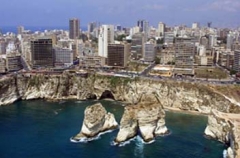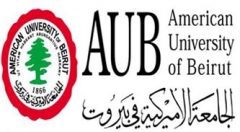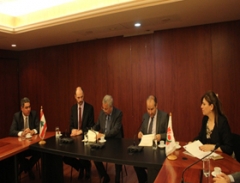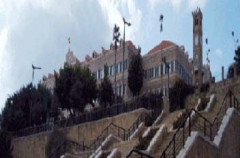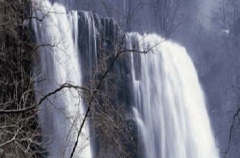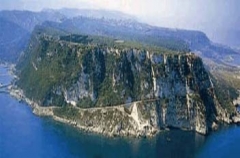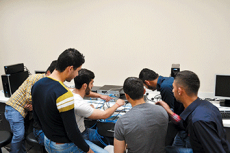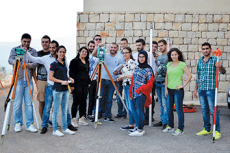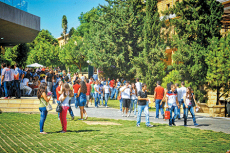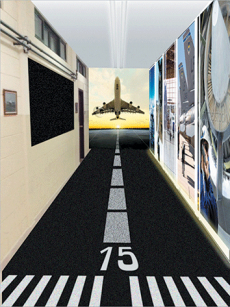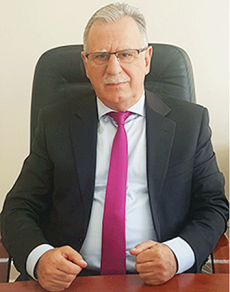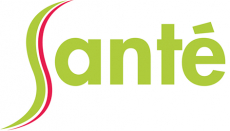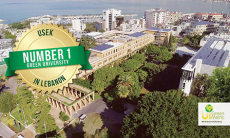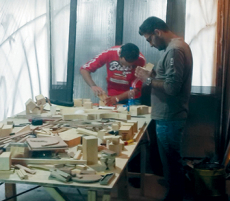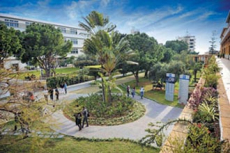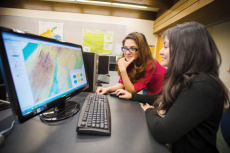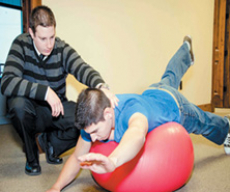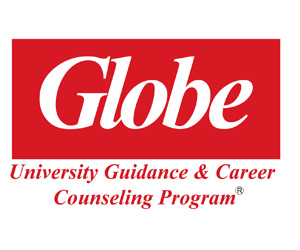Displaying items by tag: Lebanon
List of Universities In Lebanon
| Website | |
| Lebanese University | http://www.ul.edu.lb/ |
| American University of Beirut, AUB | http://www.aub.edu.lb/ |
| Saint Joseph University, USJ | http://www.usj.edu.lb/ |
| Lebanese American University, LAU | http://www.lau.edu.lb/ |
| Notre Dame University Louaize, NDU | http://www.ndu.edu.lb/ |
| USEK, KASLIK | http://www.usek.edu.lb/ |
| University of Balamand | http://www.balamand.edu.lb/ |
| ALBA, Sin el Fil – Beirut | http://www.whereleb.com/ |
| Haigazian University, HU | http://www.haigazian.edu.lb/ |
| Sagesse(la) University,ULS | http://www.uls.edu.lb/ |
| Antonin University, UPA | http://www.upa.edu.lb/ |
| American University of Technology | http://www.aut.edu/ |
| American University of Science & Technology, AUST | https://www.aust.edu.lb/ |
| Lebanese International University, LIU | http://www.liu.edu.lb/lb/ |
| Arab Open University, AOU | http://www.aou.edu.lb/ |
| Beirut Arab University, BAU | http://www.bau.edu.lb/ |
| Université Sainte Famille, USF | http://www.usf.edu.lb/en/ |
| Arts, Sciences & Technology University in Lebanon, AUL | http://aul.edu.lb/ |
| Académie des Hautes Etudes Diplomatiques et des Relations Internationales | |
| American International University California University | |
| American Pacific International University | http://www.alblebanon.com/business/ |
| Arab Baptist Theological Seminary Universities | http://www.abtslebanon.org/ |
| Lebanese Canadian university,LCU | http://www.lcu.edu.lb/ |
| Beirut Islamic University, Shariah Faculty Universities | http://www.biu.edu.lb/ |
| Continuing Education Center, CEC | https://www.aub.edu.lb/REP/CEC/ |
| Global University, GU | http://www.gu.edu.lb/ |
| Islamic University of Lebanon, IUL | http://iul-islamic-university-of-lebanon.lebanonuniversities.tel/ |
| Jinan University, JU Universities | http://www.jinan.edu.lb/pages/en/about-jul |
| Kafaat (al), Institut Universitaire | http://www.al-kafaat.org/universityeducation.html |
| Lebanese German University, LGU | http://www.lgu.edu.lb/ |
| Modern University for Business & Science, M.U.B.S. | |
| Manar (al) University of Tripoli, MUT | http://www.mut.edu.lb/ |
| Matn University, Haret Hreik, Beirut | http://www.muc.edu.lb/ |
| Mediterranean Bible College, MBC | http://www.alblebanon.com/business/ |
| Mediterranean Institute of Management & EMA | www.whereleb.com |
| Near East School of Theology | http://www.theonest.edu.lb/ |
| Middle East University, MEU | http://meu.edu.lb/ |
| Mediterranean University of Beirut, MUB | http://www.alblebanon.com/business/ |
|
Université de Technologie et de Sciences Appliquées Libano-Française |
http://www.ulf.edu.lb/ |
جمعية خريجي الجامعة الأميركية تعقد مؤتمرها السنوي ال 7 في بيروت
اعلنت الجمعية العالمية لخريجي الجامعة الأميركية في بيروت في بيان اليوم، عن عقد مؤتمرها السنوي السابع يومي 22 و23 كانون الثاني الجاري، في كلية سليمان العليان لإدارة الأعمال في الجامعة.
وسيضم المؤتمر ممثلين من 62 فرعا لخريجي الجامعة في جميع أنحاء العالم ويفتتح يوم 22 كانون الثاني بين السادسة والنصف والسابعة والنصف، في قاعة محاضرات المعماري، كلية سليمان العليان بكلمة من رئيسة الجمعية وفاء صع ورئيس الجامعة الدكتور فضلو خوري. ويتكلم بعدهما خطيب الاحتفال نعمت افرام عن تجربته في الجامعة وما بعدها.
وتعقد يوم 23 بين العاشرة صباحا والثانية عشرة ظهرا، ندوة بعنوان "أن نكون عالميين - انطباعات من جمعيات دولية بارزة للخريجين". وستجمع أربعة خريجين من الجامعة ترأسوا جمعيات خريجين محلية وعالمية لجامعات أخرى وهم: نيكولا شماس، ناجي رزق، وفاء صعب ولمياء رستم شحادة.
ويعقد كذلك يوم 23 كانون الثاني، بين الواحدة والثالثة بعد الظهر، لقاء عمل بين خريجي الجامعة حول العالم كشركاء في الاحتفال بالذكرى المئة والخمسين لتأسيس الجامعة.
اتفاقية تعاون بين الجامعة اللبنانية وجامعة تروي الفرنسية
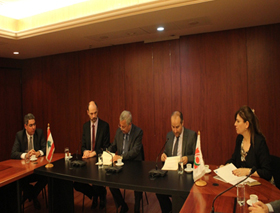
Study In Lebanon
As ancient as the cedar tree, as mighty as the oak and as persevering as the mountain wall; this is Lebanon through and through, ever since the dawn of time.
Lebanon's diverse patchwork of Mediterranean-lapped coast, rugged alpine peaks, and green fertile valleys is packed into a parcel of land some 225km long and 46km wide – an area approximately the size of Cyprus or Connecticut.
An ancient land, Lebanon features in the writings of Homer and in the Old Testament.Its cities were major outposts and seaports in Phoenician and Roman times, just two of the great civilizations that touched this important Middle Eastern crossroads.
The cosmopolitan flair of modern-day Beirut, the gastronomic renown of the country's food and wine, and an educated and outward-looking population complement a country that is both traditional and progressive in outlook. For all the flavors of its storied past and rugged natural beauty, Lebanon is a well-kept tourist secret that begs exploration.
There are four main geographic regions in Lebanon, differentiated by topography and climate. From west to east, they include: the coastal plain, the Mount Lebanon Range, the Békaa Valley, and the Anti-Lebanon Range.

The Anti-Lebanon Range is a stretch of arid mountains that rise to the east of the Békaa Valley and form part of the country's eastern border with Syria.
The Békaa Valley, known in ancient times as “the breadbasket” or “granary” of the Roman Empire, is still the country's main agricultural region. Located on a high plateau between the country's two mountain ranges, the river-fed Békaa supports the production of tomatoes, potatoes, wheat, olives, and grapes, even despite summers that are hot and dry.
Besides some of Lebanon's best wineries (Ksara, Kefraya, Massaya), the Békaa's major attraction is the ruins at Baalbek. Originating as a place of worship to Baal, the Phoenician Sun God, Baalbek was known in Greco-Roman times as the famous Heliopolis, or “City of the Sun.” Perhaps because of the region's agricultural importance in feeding the inhabitants of the Roman Empire, some of the largest Roman temples ever constructed were erected at this site. The construction lasted over 200 years, and the well-preserved temples honor Jupiter, Bacchus, and Venus.
The lovely Lebanese coast is framed by the Mediterranean Sea to the west and the Mount Lebanon Range to the east, its temperate climate bringing in sunny, hot summers and cool, rainy winters. The daytime temperature in the summer, which averages 30°C (86°F), encourages people to head to the beach or to the higher, altitude-cooled mountain slopes. In the coastal cities of Saida (Sidon) and Jbail (Byblos), tourists can enjoy the rare opportunity to snorkel amongst long-submerged Phoenician ruins, while excellent hiking is a mere hour away in the Chouf region of the Mount Lebanon Range.
The Mount Lebanon Range includes numerous rivers that fizz with snowmelt, steep-walled gullies that shade grottoes once the hideout to those fleeing persecution, and also Lebanon's highest summit, Qornet Es-Saouda (3,090m). In winter, the high peaks are blanketed with snow, lending Lebanon its name, Lubnan, the Arabic word for “white.” Lebanon boasts a number of world-class ski resorts, one of only a couple countries in the Middle East where you can ski. The ski season runs from December until April.

The Mount Lebanon Range is also the location of Lebanon's Cedar Reserves. The great cedar forests of Lebanon, now protected, are famous for their use in the construction of some of the holiest buildings in the region, indeed the world, including Jerusalem's Dome of the Rock and Solomon's Temple.
To visit Lebanon is to dispel preconceived notions that linger from a relatively short moment in a long, vivid, and fascinating history: drink in the energetic, urbane vibe of revitalized Beirut; explore a diverse and beautiful landscape that lends itself easily to an unforgettable (and largely untrammeled) multi-sport adventure; marvel at archaeological wonders that are windows into the cradle of civilization; and simply enjoy the welcome of a people who are naturally hospitable, friendly, and gregarious.
CULTURE
An interesting archaeological relic found throughout Lebanon is the hundreds of well-preserved mosaics from the Roman and Byzantine eras. Countless colorful, tiny stones form intricate images of mythological figures, religious deities, and geometric designs.The mosaic is symbolic of modern-day Lebanon, which is a country characterized by a diversity of cultures, traditions, and religions interwoven through time. It is this unique diversity which fascinates travelers.
Thanks to its location at the crossroads of Asia, Europe, and Africa, Lebanon has been shaped by many civilizations throughout history. Its position as a meeting point for diverse peoples is evident in the extraordinary richness of its archaeological sites and historical monuments. From Stone Age settlements to Phoenician city-states, from Roman temples to rock-cut Christian hermitages, from Crusader Castles to Mamluke mosques and Ottoman hammams, the country's historical sites are a true encyclopedia of ancient and modern world history.

Modern Lebanese society is characterized by this same cultural diversity. Most Lebanese people speak Arabic, English, and French. As you walk the streets of downtown Beirut, you will pass domed mosques and steepled churches, reflecting the country's religious and architectural legacies – Sunni, Shiia, and Druze Muslims; Maronite, Eastern Orthodox, and other Christians; and many others. Regionally, each part of the countryside has its own local flavor, with different villages preserving a different culinary, artistic, religious, or cultural traditions.
A visit to any of Lebanon's ancient archaeological ruins, traditional villages, or religious sites will truly give you a taste of the cultural mosaic of this captivating country.
CLIMATE
Lebanon is blessed with a mild Mediterranean climate and four distinct seasons. (June to September) is made for sun worshippers and water enthusiasts, with temperatures along the coast ranging from 20-32°C (68-90°F). Clear skies and little rain are perfect for outdoor cafés and seaside fun. Alternatively, head to the mountains for nice walks and cooler weather, typically 6-22°C (45-70°F).
Summer is the season for sampling mouth-watering cherries and vineyard grapes in the Békaa Valley.(October-November) brings crisp, cool weather to the mountains, 5-20°C (40-68°F), while remaining pleasantly warm on the coast and in the South, 15-28°C (60-85°F). Fall is a good time for apple picking in the North and viewing the harvesting of olives and machinations of olive presses all over the country.
(December to mid-March) is the time for outdoor sports, with six ski resorts catering to skiers and snowboarders of all skill levels, and kilometers of cross-country skiing and snowshoe trails to be explored. Because winter is the rainy season, the mountains get considerable snowfall. Temperatures fall to below 0°C at night and range from -5°C-5°C (25-40°F) during the day. The coast is wet and cool, with temperatures ranging from 10-20°C (50-67°F).
Fall and winter can be the ideal time to visit Lebanon's historical attractions and ruins while avoiding crowds and hot weather. On a fresh, crisp day you might find yourself as the sole visitor amidst the majestic ruins of Sour (Tyre) or Baalbek, feeling almost transported to the ancient days of the Phoenicians or Romans.

Lebanon warms again in the (April-May). As a result of the winter rain and the melting snow, the scenery comes alive with wildflowers, making spring the prime opportunity for hiking Lebanon's mountain trails and discovering its unique flora and fauna. Temperatures range from 0-15°C (32-60°F) in the mountains to 15-25°C (58-72°F) along the coast.
Higher Education In Lebanon
Lebanon's higher education is the oldest in the region and dates back to 1866 when the American University of Beirut (AUB) was founded under the name of the Syrian Evangelical College, followed by the Universityof Saint Joseph (USJ) in 1875,then by the Lebanese American University (LAU) in 1947as a Beirut College for Women.
The Lebanese University (LU) which is the only public university in the country was founded in 1951.
Haigazian University was founded in 1955,followed by the Beirut Arab University (BAU) in 1960 in collaboration with the Egyptianuniversity of Alexandria.
Most of the 40 higher education institutions currently in operation in Lebanon were legalised in the late nineties
when the private sector flourished in a suddenand rapid expansion following the 15 year civil war that Lebanon suffered between 1975 and1990 and which had a very damaging impact on the country’s higher education sector.The freedom and independence of Lebanese higher education are protected under the Constitution. Tertiary education in Lebanon is divided into two categories; vocational tertiary education and general or non-vocational higher education.
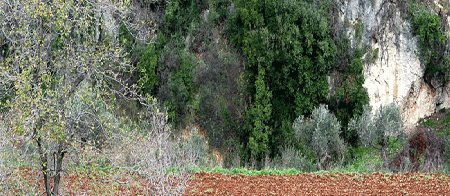
Higher education in Lebanon composes of Technical and Vocational Institutes, University Colleges, University Institutes and Universities. The Lebanese University is the only public institution. The Ministry of Education and Higher Education administrates the private and public sectors and Technical and Vocational Institutes are under the Directorate General of Technical and Vocational Education Directorate General of Higher Education has responsibility for University Colleges, University Institutes and Universities).
According to the World Bank database, gross enrollment rate of tertiary education is 46.9 percent for male, 56.3 percent for female, and 51.6 percent for total. (The World Bank 2009) Private enrollment share of tertiary education is 53.4 percent.
Female students are seen in every university program or field of specialization..
Following high school, Lebanese students may choose to study at a university, a college, or a vocational training institute. The number of years to complete each program varies.

While the Lebanese educational system offers a very high quality and international class of education, the local employment market lacks enough opportunities, thus encouraging many of the young educated to travel abroad; Successful Lebanese engineers, doctors, businessmen, etc. are found practically all over the world. Lebanon has 42 nationally-accredited universities, several of which are internationally recognized. The American University of Beirut (AUB) and the Université Saint-Joseph (USJ) were the first Anglophone and the first Francophone universities to open in Lebanon respectively. The forty-one universities, both public and private, largely operate in French, or English as these are the most widely used foreign languages in Lebanon.
At the English universities, students who have graduated from an American-style high school program enter at the freshman level to earn their baccalaureate equivalence from the Lebanese Ministry of Higher Education. This qualifies them to continue studying at the higher levels. Such students are required to have already taken the SAT I and the SAT II (Subjects Test) upon applying to college, in lieu of the official exams. On the other hand, students who have graduated from a school that follows the Lebanese educational system are directly admitted to the sophomore year. These students are still required to take the SAT I, but not the SAT II.
List of Universities is available in another section. You may go to Universities






